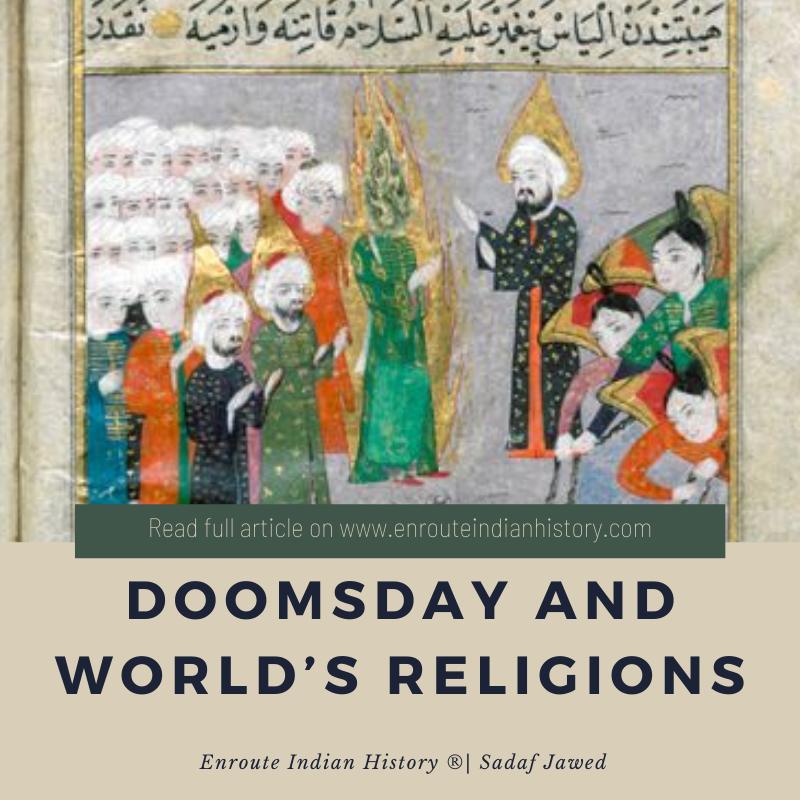
Article by EIH Researcher and Writer
Sadaf Jawed
In all religions, ideas about the past, the present and future were shaped and made meaningful by beliefs and expectations related to the End Times, the doomsday or the Judgement day. The idea of apocalyptic prophecy has haunted the humanity for centuries across cultures and has been integral to Judasim, Christianity, Islam, Hinduism and Buddhism. It is a common narrative that arises in the moment of social or political crisis, as people try to process the unfathomable events. In present times when the world is going through a dystopian phase of pandemic, uncertainty and sufferings, one wonders if this is the End Times. Are we really living in the times that all these scriptures prophesied about?
Be it Abrahamanic religions, norse mythology or Asian religions, though very different in origin and beliefs, the idea of a final judgment unites them all. Across religions the Doomsday is usually believed to be preceded by a period of socio-political crisis as well as moral decay and would range from a final battle between good and evil resulting in a new divine order to death, divine judgment and eternal afterlife. This period is often associated with anticipation of the Second Coming of Christ or the advent of messianic figures such as the Hindu Kalki and the Buddhist Maitreya that could bring both hope and fear.
Around 1300 B.C. Zoroastrianism laid the foundation for Judeo-Christian teachings about the apocalypse. Zoroastrians taught that as humans succumb to temptation and become increasingly lawless and deceitful, society will break down. Nature itself will begin to shut down, with the sun becoming smaller with increasingly dark clouds covering up the sky and bringing foul-smelling rain. Crops and trees will wither away. Finally, an army of long-haired demons who are “powerful and most skilled in smiting,” will invade from the east and will be met by another army, composed of holy warriors, who will engage in one last epic battle to defend goodness and purify the holy places that the demons have desecrated. Zoroastrians have no concept of an eternal hell, they believe that the wicked will be judged and punished in an ordeal of molten metal. Evil will be destroyed, and purified sinners will be renewed for eternity.
Jewish prophets such as Daniel foretold an apocalyptic future, using “light vs. dark” imagery and haunting descriptions of the end in the Book of Daniel (a part of the Jewish scriptures). The Dead Sea Scrolls, traditionally ascribed to a Jewish sect that retreated into the wilderness at Qumran to await the end of the world, also describe a final confrontation between the armies of God and demonic forces finally leading to The Judgment day.
In the Bible, it is foretold that Jesus Christ will descend from heaven in the guise of a warrior-king, leading an army of resurrected saints and martyrs to victory over the demonic hordes of the Antichrist at the final Battle of Armageddon. The word ‘Armageddon’ is thought to originate from the Hebrew for “mount of Megiddo.” Located in present-day Israel, Megiddo, an old city, was the site of various fights. A few Christians decipher the Book of Revelation as a guide that spreads out precisely how the world will end. They battle that Judgment Day will happen on Armageddon and Jesus will spare the genuine devotees, while non-adherents abandoned will confront huge torment.
Islam likewise is rich in its conceptual expansion of the doctrine of the Last Judgment. The Day of Judgment is one of the five cardinal beliefs of Muslims. Islam generally ties the end of the world to the Second Coming of Jesus, whom Muslims see as a prophet. In Islamic eschatology, stories about death, the afterlife, and the end of the world play a vital role in the Qur’an and ḥadīth literature, as almost every sūrah refers to eschatology, particularly to the physical rewards and punishments of heaven and hell, reminding believers that earthly deeds had an everlasting impact on the fate of the soul. As the end approaches, Muslims believe, there will be a period of moral decay. The demons Gog and Magog (who are also in the Book of Revelation and rabbinic literature) will break through a barrier of iron and molten copper. A one-eyed figure, Dajjal, resembling the Antichrist, will bring chaos and destruction, according to Muslim tradition. Eventually, Dajjal will be slain by Jesus, and God will reward the good with paradise and condemn the evil to hell. The majority of Muslims as well as the Shiite tradition of Islam believe that a savior, Imam Mahdi or ”the rightly guided one whose return everyone is waiting for” and who is a direct descendant of the prophet Mohammed will initiate the end time.
While in Hinduism, there are several cycles of time, hundreds of thousands of years long, and there are several Doomsdays. The Sanskrit word for Doomsday is ”pralaya,” which means ”dissolution.” Each cycle, or ”kalpa,” has four ages. We are now in the fourth age, the ”kali yuga” age. In this cycle, three gods—Brahma, Vishnu and Shiva—all play a role. Brahma is the creator of the universe, while Vishnu preserves it during its existence. Shiva’s job is destroying the universe, so that it can be recreated. It is believed that during the end times, Hindu god Kalki, the last incarnation of Vishnu, will come to destroy the present cosmos and will restore order. Kalki is sometimes represented as riding a white horse and carrying a sword. Hinduism has no single day of judgment, like the Abrahamnic religions.
Unlike most religions, Buddhism says that the universe never begins or ends, The cosmos we live in is only one of an infinite number. There definitely is an apocalyptic end to our world, by wind, fire or water, but there is no date attached to the destruction of the world. Buddhism incorporates various doctrines. One Buddhist metaphor speaks of the afterlife as a passage into heaven or hell or another human existence. The individual’s destiny is determined by ‘karma’, the effect of his deeds. This passage is sometimes represented as a judgment, presided over by a divine figure. There is no single judgment day in most Buddhist sects. Heavens and hells are usually temporary states until the individual is consigned to another rebirth. The goal is to escape suffering and attain nirvana, a condition beyond being or non-being. Some Buddhists believe that another Buddha named Maitreya, who is somewhat similar to the Messiah, will come and establish an ideal society.
The present dystopian times of chaos, uncertainty and disease is likely to trigger paralyzing anxiety that the world is dissolving, resulting in a sense of detachment and/or existential crisis. It is in times of chaos and moral collapse that people long for a Messiah to relieve them once and for all from their pain and suffering. Therefore, historically pandemics have been attributed to both religious and naturalistic causes. Throughout history pandemics and apocalyptic narratives have run closely together. As one example, explanations of the Black Death (1347–1352) involved ideas of sin and apocalypse, acts of God and alignments of the planets. For many the Black Death signaled the end-times. In another case, the 1918 Spanish flu epidemic was seen as an eschatological sign of Christ’s second coming. A pamphlet, ‘The Millennium—A Prophetic Forecast’, warned readers that the flu epidemic was only the beginning of the affliction that was stated in the Book of Revelations. The Covid-19 pandemic is no different than the earlier pandemics and thus has had a similar impact on the population at large. It has threatened key symbolic frameworks and has presented an unprecedented challenge for both people and society globally in terms of its impact on mortality, morbidity and economic decline. It has highlighted issues of work, social inequality, individualism and social interaction generally, thus changing the ways in which we lead our lives. The socio-political scenario of present time has altered our reality and this fear of the unknown ultimately leads to finding solace in apocalyptic literature. The promise that there will be a final Judgment day gives people hope and the strength to deal with this unfair world.
References :
Kovach, Keri. 2016. ‘Fact or Fiction: The Social and Cultural Beliefs That Drive DoomsDay Prophecies’. Master’s thesis, Harvard Extension School.
Wieser, Eltschinger and Johann Heiss., ed. ‘Cultures of Eschatology’.
“A Conversation With Harold Camping, Prophesier of Judgment Day”. New York Magazine. May 2011
Stone, Jon R., ed. (2000). Expecting Armageddon: Essential Readings in Failed Prophecy. New York: Routledge
Patrick J. Kiger, ‘How the World’s religion view Apocalypticism’
https://www.nytimes.com/2020/04/02/us/coronavirus-apocalypse-religion.html


















